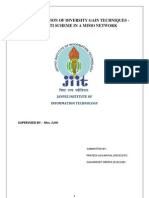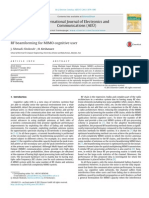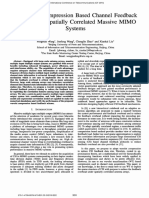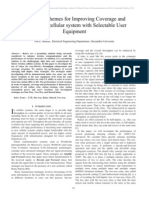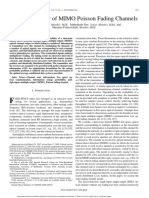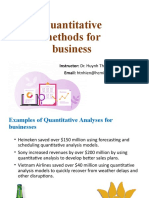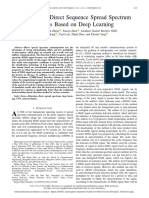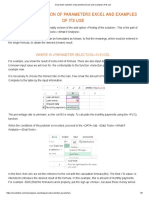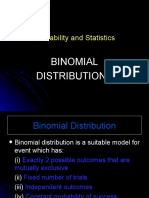Cooperative Feedback For Multiantenna Cognitive Radio Networks
Cooperative Feedback For Multiantenna Cognitive Radio Networks
Uploaded by
Shobhita GuptaCopyright:
Available Formats
Cooperative Feedback For Multiantenna Cognitive Radio Networks
Cooperative Feedback For Multiantenna Cognitive Radio Networks
Uploaded by
Shobhita GuptaOriginal Title
Copyright
Available Formats
Share this document
Did you find this document useful?
Is this content inappropriate?
Copyright:
Available Formats
Cooperative Feedback For Multiantenna Cognitive Radio Networks
Cooperative Feedback For Multiantenna Cognitive Radio Networks
Uploaded by
Shobhita GuptaCopyright:
Available Formats
IEEE TRANSACTIONS ON SIGNAL PROCESSING, VOL. 59, NO.
2, FEBRUARY 2011
747
Cooperative Feedback for Multiantenna Cognitive Radio Networks
Kaibin Huang, Member, IEEE, and Rui Zhang, Member, IEEE
AbstractCognitive beamforming (CB) is a multiantenna technique for efcient spectrum sharing between primary users (PUs) and secondary users (SUs) in a cognitive radio network. Specically, a multiantenna SU transmitter applies CB to suppress the interference to the PU receivers as well as enhance the corresponding SU-link performance. In this paper, for a multiple-input-singleoutput (MISO) SU channel coexisting with a single-input-singleoutput (SISO) PU channel, we propose a new and practical paradigm for designing CB based on the nite-rate cooperative feedback from the PU receiver to the SU transmitter. Specically, the PU receiver communicates to the SU transmitter the quantized SU-to-PU channel direction information (CDI) for computing the SU transmit beamformer, and the interference power control (IPC) signal that regulates the SU transmission power according to the tolerable interference margin at the PU receiver. Two CB algorithms based on the PUs cooperative feedback are proposed: one restricts the SU transmit beamformer to be orthogonal to the quantized SU-to-PU channel direction and the other relaxes such a constraint. In addition, cooperative feedforward of the SU CDI from the SU transmitter to the PU receiver is exploited to allow more efcient cooperative feedback from the PU receiver. The outage probabilities of the SU link for different cooperative feedback/feedforward algorithms are analyzed, from which the optimal bit-allocation tradeoff between the CDI and IPC feedback is characterized. Index TermsBeamforming, cognitive radio, cooperative communication, interference channels, limited feedback, multiantenna systems.
I. INTRODUCTION N a cognitive radio network, secondary users (SUs) are allowed to access the spectrum allocated to a primary network so long as the resultant interference to the primary users (PUs) is within a tolerable margin [1]. Cognitive beamforming (CB) is a promising technique that enables a multiantenna SU transmitter to regulate its interference to each PU receiver by intelligent beamforming, and thereby transmit more frequently with larger power as compared with a single-antenna SU trans-
Manuscript received March 12, 2010; revised June 27, 2010, September 27, 2010; accepted October 13, 2010. Date of publication October 25, 2010; date of current version January 12, 2011. The associate editor coordinating the review of this manuscript and approving it for publication was Prof. Yimin Zhang. This paper was presented in part at the IEEE Vehicular Technology Conference, Taipei, Taiwan, R.O.C., May 1619, 2010. This work was partially supported by the Korean Research Foundation under the grant 2010-8-1144 and the National University of Singapore under the grant 263-000-589-133. K. Huang is with the School of Electrical and Electronic Engineering, Yonsei University, Seoul 120749, South Korea (e-mail: huangkb@me.com). R. Zhang is with the Institute for Infocomm Research, Singapore 138632, Singapore, and the Department of Electrical and Computer Engineering, National University of Singapore, Singapore (e-mail: elezhang@nus.edu.sg). Color versions of one or more of the gures in this paper are available online at http://ieeexplore.ieee.org. Digital Object Identier 10.1109/TSP.2010.2089623
mitter. In general, the optimal CB designs require the SU transmitter to acquire the channel state information (CSI) of its interference channels to the PU receivers and even that of the primary links, which is difcult without the PUs cooperation. By considering a two-user-cognitive-radio network comprising a multiple-input-single-output (MISO) SU link and a singleinput-single-output (SISO) PU link, this paper establishes a new approach of enabling CB at the SU transmitter based on the nite-rate CSI feedback from the PU receiver and presents a set of jointly designed CB and PU feedback algorithms. The effect of feedback-CSI quantization on the SU link performance is quantied, yielding insights into the feedback requirement in practical systems. Existing CB designs assume that the SU transmitter either has prior CSI of the interference channels to the PU receivers or can acquire such information by observing the PU transmissions, which may be impractical. Assuming perfect CSI of the SU-to-PU channels, the optimal CB design is proposed in [2] for maximizing the SU throughput subject to a given set of interference power constraints at the PU receivers. The perfect CSI assumption is relaxed in [3] and a more practical CB algorithm is designed where a SU transmitter estimates the required CSI by exploiting channel reciprocity and periodically observing the PU transmissions. However, channel estimation errors can cause unacceptable residual interference from the SU transmitter to the PU receivers. This issue is addressed in [4] by optimizing the cognitive beamformer to cope with CSI inaccuracy. Besides CB, the power of the SU transmitter can be adjusted opportunistically to further increase the SU throughput by exploiting the primary-link CSI as proposed in [5] and [6]. Such CSI, however, is even more difcult for the SU to obtain than that of the SU-to-PU channels if the PU receivers provide no feedback. For multiple-input multiple-output (MIMO) wireless systems, CSI feedback from the receiver enables precoding at the transmitter, which not only enhances the throughput but also simplies the transceiver design [7]. However, CSI feedback can incur substantial overhead due to the multiplicity of MIMO channel coefcients. This motivates active research on designing efcient feedback quantization algorithms, called limited feedback [8]. There exists a rich literature on limited feedback [9] where MIMO CSI quantizers have been designed based on various principles such as line packing [10] and Lloyds algorithm [11], and targeting different systems ranging from single-user beamforming [10], [12] to multiuser downlink [13][15]. In view of prior work, limited feedback for coexisting networks remains a largely uncharted area. In particular, there exist few results on limited feedback for cognitive radio networks.
1053-587X/$26.00 2010 IEEE
748
IEEE TRANSACTIONS ON SIGNAL PROCESSING, VOL. 59, NO. 2, FEBRUARY 2011
In traditional cognitive radio networks, primary users have higher priority of accessing the radio spectrum and are reluctant to cooperate with secondary users having lower priority and belonging to an alien network [16]. However, internetwork cooperation is expected in the emerging heterogeneous wireless networks that employ macro-cells, micro-cells, and femto-cells to serve users with different priorities [17]. For instance, a macrocell mobile user can assist the cognitive transmission in a nearby femto-cell. Thus, the design of efcient cooperation methods in cognitive radio networks will facilitate the implementation of next-generation heterogeneous wireless networks. This paper presents a new and practical paradigm for designing CB based on the nite-rate CSI feedback from the PU receiver to the SU transmitter, called cooperative feedback. To be specic, the PU receiver communicates to the SU transmitter i) the channel-direction information (CDI), namely the quantized shape of the SU-to-PU MISO channel, for computing the cognitive beamformer and ii) the interference-power-control (IPC) signal that regulates the SU transmission power according to the tolerable interference margin at the PU receiver. Our main contributions are summarized as follows. 1) We present two CB algorithms for the SU transmitter based on the nite-rate cooperative feedback from the PU receiver. One is orthogonal cognitive beamforming (OCB) where the SU transmit beamformer is restricted to be orthogonal to the feedback SU-to-PU channel CDI and the SU transmission power is controlled by the IPC feedback. The other is non-orthogonal cognitive beamforming (NOCB) for which the orthogonality constraint on OCB is relaxed and the matching IPC signal is designed. 2) In addition to cooperative feedback, we propose cooperative feedforward of the secondary-link CSI from the SU transmitter to the PU receiver. The feedforward is found to enable more efcient IPC feedback from the PU receiver, allowing larger SU transmission power. 3) We analyze the secondary-link performance in terms of the signal-to-noise ratio (SNR) outage probability for OCB. In particular, regardless of whether there is feedforward, the SU outage probability is shown to be lower-bounded in the high SNR regime due to feedback CDI quantization. The lower bound is proved to decrease exponentially with the number of CDI feedback bits. 4) Finally, we derive the optimal bit allocation for the CDI and IPC feedback under a sum feedback rate constraint, which minimizes an upper bound on the SU outage probability. The remainder of this paper is organized as follows. Section II introduces the system model. Section III presents the jointly designed CB and cooperative feedback algorithms. Section IV and Section V provide the analysis of the SU outage probability and the optimal tradeoff between the CDI and IPC feedback-bit allocation, respectively. Simulation results are given in Section VI, followed by concluding remarks in Section VII. II. SYSTEM MODEL We consider a primary link coexisting with a secondary link, and the receiver as illustrated in Fig. 1. The transmitter of the primary link both have a single antenna, while the secondary link comprises a multiantenna transmitter and
Fig. 1. Coexisting single-antenna primary and multiantenna secondary links.
a single-antenna receiver . The multiple antennas at are employed for beamforming where the beamformer is represented by . All channels follow independent block fading. The channel coefcients of the primary and secondary links are independent and identically distributed (i.i.d.) circularly-symmetric-complex-Gaussian random variables with zero mean and . Consequently, the primary unit variance, denoted by has the power , where is signal received at the transmission power of and the primary channel power that is exponentially distributed with unit variance, denoted . The MISO channels from to and from to by are represented by the vectors consisting of i.i.d. elements and comprising i.i.d. elements, accounts for a larger path loss respectively, where and than that between and (or between between and ). To facilitate analysis, is decomposed into the channel gain and channel shape , ; similarly, let . Baed on and hence and follow the above channel model, the channel power independent chi-square distributions with complex degrees of freedom. The primary receiver cooperates with the secondary transto maximize the secondary-link throughput without mitter compromising the primary-link performance. We assume that estimates and perfectly and has prior knowledge of . This enables to the maximum SU transmission power compute and communicate to the IPC signal and the CDI . Under a nite-rate feedback constraint, the IPC and CDI feedback must be both quantized. Let denote the output of quantizing . Following [18] and [19], we adopt the quantization model where lies on a hyper sphere-cap centered at and its radius depends on the quantization resolution. Specically, the has the following cumulative quantization error [18]1: distribution function for otherwise (1)
where is the number of CDI feedback bits. The IPC feedback quantization is discussed in Section III. to , called local feedback also reFeedback of from quired for computing the beamformer . We assume no feedto . Thus, the transmission power of back of from is independent of . We also consider the scenario where
1y
denotes the Hermitian-transpose matrix operation.
HUANG AND ZHANG: COOPERATIVE FEEDBACK FOR MULTI-ANTENNA COGNITIVE RADIO NETWORKS
749
sends to , called feedforward, prior to cooperative feedto predict the beamformer back. This information is used by and thereby tolerate larger transmission power at . For at simplicity, the local feedback and the feedforward are assumed perfect. This assumption allows us to focus on the effect of nite-rate cooperative feedback. The performances of the primary and secondary links are both measured by the SNR or signal-to-interference-plus-noise ratio (SINR) outage probability. Accordingly, the data rates for the primary and secondary links are xed as and , respectively, where and specify the receive SNR/SINR thresholds for correct decoding. The receive are given by SNR and SINR at (2)
, where is the quantized IPC satises the constraint feedback signal to be designed in the sequel. It follows from above discussion that the beamformer solves the following optimization problem
(7) To solve the above problem, we decompose as where is an vector with unit norm such that , satisfy . With this and the coefcients decomposition, the optimization problem in (7) is rewritten as
(8) where is the PU transmit SNR given by , and the and are i.i.d. random noise samples at both variables. The PU outage probability is unaffected by the SU transmission and can be written as It follows that implements the maximum-ratio transmission [20] and is thus given as (9) 1) The Design of IPC Feedback: The unquantized IPC feedback signal, denoted as , is designed such that the constraint is sufcient for enforcing that in (3). The quantization of will be discussed in the next subsection. The constraint in (3) can be translated into one on the residual interference power from to as follows. Let denote the null space of and its basis vectors are represented as . It follows from the CDI quantization model in Section II that (10) Without loss of generality, let since and dene . Thus, from (10) and since , we can obtain that . Furthermore, dene and can be decomposed as (11) III. COGNITIVE BEAMFORMING AND COOPERATIVE FEEDBACK ALGORITHMS The beamforming algorithms are designed to minimize the secondary link outage probability under the PU-outage-probability constraint in (3). The OCB and NOCB algorithms together with matching IPC feedback designs are discussed in separate subsections. A. Orthogonal Cognitive Beamforming The OCB beamformer at , denoted as , suppresses inand yet enhances in (5). To this end, terference to is constrained to be orthogonal to the feedback CDI , giving the name OCB. Despite the orthogonality constraint, there exto due to the quantization ists residual interference from error in . The interference power can be controlled to satisfy to . Specifthe constraint in (3) using IPC feedback from ically, the transmission power of , dened as , represent appropriate phase rotations. where the angles Using the above expression, can be upper-bounded as (12) (13) (14) (15) where (13) is obtained by substituting (9) and (11). Note that requires that can be derived from the computing at from . Therefore, can be obtained at feedforward of using (14) for the case of feedforward or otherwise approximated using (15). Next, based on the principle of opportunistic power control in [5], the constraint in (3) is equivalent to that if (16)
(3) (4) where the equality in (3) species a constraint on the SU CB design and (4) follows from that the primary channel gain is dis. In a heterogeneous network, a primary transtributed as mitter such as a macro-cell base station is located far away from a receiver served by a secondary transmitter such as a femto-cell to can be asbase station. Therefore, interference from is sumed negligible and the receive SNR at (5) It follows that the SU outage probability is (6)
750
IEEE TRANSACTIONS ON SIGNAL PROCESSING, VOL. 59, NO. 2, FEBRUARY 2011
where (17) If , can be arbitrarily large since experiences outage even without any interference from . For the case without feedforward, the IPC signal is obtained by combining (15) and (16) as otherwise. (18)
where . In other words, with NOCB controls transmission power in the direction specied by rather than suppressing it. In addition, satises a power with . The parameters constraint and constitute the quantized IPC feedback signal designed in the sequel. Under the above constraints, the design of to maximize the receive SNR at can be formulated as the following optimization problem:
The counterpart of for the case of feedforward, denoted as , follows from (14) and (16) as otherwise. (19)
(22) To solve the above problem, we write where with identical to that in (11) and . An optimization problem having the same form as (22) is solved in [2]. Using [2, Theorem 2] and , we obtain the following lemma. Lemma 1: The NOCB beamformer is given by where If (23) If (24) Note that the beamformer in (23) performs the maximumratio transmission [20]. In the remainder of this section, the IPC-feedback signal is designed to enforce the constraint in (3). The unquan, is rst designed as tized version of , denoted as follows. Similar to (16), the constraint in (3) can be transformed into the following constraint on the residual interference power from to :
is looser than in the case Note that the constraint since . of 2) The Quantization of IPC Feedback: Let denote the -bit output of quantizing . The rst bit indicates whether there is an outage event at ; the following bits represent if is not in outage (i.e., ) or otherwise are neglected by . Given , is constrained to take on values from nonnegative scalars, denoted by a nite set of where . Note that the optimal design of for minimizing the SU outage probability requires additional knowledge at of the secondary-link data rate and channel distribution. For simplicity, we consider the suboptimal design of whose elements partition the space of using the criterion of equal probability.2 Specically, and
(20) Given , dene the operator subject to . Then on is given as as
if (21) or otherwise Lemma 1 and (11),
(25)
otherwise.
. To facilitate the design, using is upper-bounded as follows:
and thus the constraint is sufcient Note that for maintaining the constraint in (16) or its equivalence in (3). Last, for the case with feedforward, the output of quantizing in (19) is given by (21) with replaced with . B. Non-Orthogonal Cognitive Beamforming The NOCB beamformer at is designed by relaxing the orthogonality constraint on OCB. We formulate the design of NOCB beamformer as a convex optimization problem and derive its closed-form solution. The matching IPC feedback signal is also designed. The NOCB beamformer, denoted as , is modied from the OCB counterpart by replacing the constraint
IPC quantizer can be improved by limiting the quantization range to and optimizing the set P using Lloyds algorithm [21]. However, the analysis is complicated. Thus, we use the current design for simplicity and do not pursue the optimization of the IPC quantizer in this work.
(26) (27) , and (27) follows from . where (26) applies requires feedforward. Therefore, Recall that computing at for the case without feedforward, the bound on in (27) should be used in designing the IPC feedback. Specically, combining (25) and (27) gives the following constraint on if (28)
2The
HUANG AND ZHANG: COOPERATIVE FEEDBACK FOR MULTI-ANTENNA COGNITIVE RADIO NETWORKS
751
where
(29) For , it follows that . For , the above constraint is invalid and thus we set ; as a result, the NOCB optimization problem in (22) converges to the OCB . Furthermore, it can be counterpart in (7), leading to for the case of observed from (26) that setting does not violate the interference constraint in (25). Combining above results gives the following IPC feedback design:
(30) where and are given in (18) and (29), respectively. It follows that the quantized IPC feedback, denoted as , is given as (31) with being a scalar quantizer codebook where designed similarly as discussed in Section III-A2. The feedback of is observed from (31) to involve the transmission of only a single scalar (either or ) with one additional bit for separating the rst two cases in (31). Note that the third case . can be represented by setting For the case with feedforward, the IPC feedback is designed by applying the constraint in (25) to the upper bound on in (26) and following similar steps as discussed earlier. The resultant quantized IPC feedback, denoted as , is (32) where signal with being the unquantized IPC feedback
Fig. 3. Performance comparison between OCB and NOCB in terms of SU outage probability versus maximum SU transmit SNR. The CDI feedback is quantized and the IPC feedback is assumed perfect. Fig. 2. SU outage probability for OCB versus maximum SU-transmit SNR for quantized CDI and perfect IPC feedback.
(33) a suitable quantizer codebook. Note that since and . In other words, feedforward relaxes the constraint on the SU transmission power. C. Comparison Between Orthogonal and Non-Orthogonal Cognitive Beamforming Regardless of whether feedforward exists, NOCB outperforms OCB since NOCB relaxes the SU transmission power constraint with respect to OCB, which can be veried by comparing the IPC signals in (18) and (19) with those in (30) and (32), respectively. Next, the performance of OCB and NOCB . Let and denote the SU converges as outage probabilities for OCB and NOCB, respectively. and
Proposition 1: For large , the SU outage probabilities for OCB and NOCB converge as (34) regardless of whether feedforward is available. Proof: See Appendix A. The above discussion is consistent with simulation results in Fig. 3. D. The Effect of Quantizing Local Feedback and Feedforward In practice, the local feedback and feedforward of must be quantized like the cooperative feedback signals. Let denote the quantized version of . The corresponding cognitive beamforming and cooperative feedback algorithms can be modied with . from those in the preceding sections by replacing
752
IEEE TRANSACTIONS ON SIGNAL PROCESSING, VOL. 59, NO. 2, FEBRUARY 2011
The error in the feedback/feedforward of at most causes a without affecting the primary loss on the received SNR at link performance, which does not change the fundamental results of this work. Note that extensive work has been carried out on quantifying the performance loss of beamforming systems caused by local feedback quantization (see, e.g., [10], [12], and [19]). Furthermore, simulation results presented in Fig. 5 conrm that the quantization of has insignicant effect on the SU outage probability, justifying the current assumption of perfect local feedback and feedforward. IV. OUTAGE PROBABILITY The CDI typically requires more feedback bits than the IPC complex vector and the latter signal since the former is an is a real scalar. For this reason, assuming perfect IPC feedback, this section focuses on quantifying the effects of CDI quantization on the SU outage probability for OCB. Similar analysis for NOCB is complicated with little new insight and hence omitted. A. Orthogonal Cognitive Beamforming Without Feedforward The outage probability depends on the distribution of the SU transmission power , which is given in the following lemma. Lemma 2: For OCB without feedforward, the distribution of for large is given as
Theorem 1: The SU outage probability for OCB without feedforward and large is
(38) where denote the upper incomplete gamma function and (39) Proof: See Appendix C. The last two terms in (38) represent the increase of the SU outage probability due to the feedback CDI quantization. The and are given asymptotic outage probabilities for large in the following two corollaries. , the SU outage probability in Corollary 1: For large Theorem 1 converges as (40) (41) This result in (40) shows that for large , saturates at a level that depends on the quality of CDI feedback because contributes residual interference to . the transmission by The saturation level of in (40) decreases exponentially with increasing , which suppresses the residual interference. More details can be found in Fig. 2 and the related discussion in Section VI. To facilitate subsequent discussion, we refer to the range of where saturates as the interference limiting regime. From (41), it can be observed that in the interference limiting increases with the number of antennas . The regime reason is that the CDI quantization error grows with if is xed, thus increasing the residual interference from to . To from growing with in the interference limiting prevent regime, has to increase at least linearly with . However, decreases with outside the interference limiting regime, as shown by simulation results in Fig. 4 in Section VI. Corollary 2: For large , the SU outage probability in Theorem 1 converges as (42) As , both links are decoupled and the limit of (42) decreases continuously with . B. Orthogonal Cognitive Beamforming With Feedforward Effectively, feedforward changes the analysis in the preceding section by replacing with . Lemma 4: The probability density function of is given as (43) in
(35)
(36) . where Proof: See Appendix B. For a sanity check, from the above results,
These are consistent with the fact that OCB with perfect CDI nulls the interference from to , alfeedback lowing to always transmit using the maximum power. Next, dene the effective channel power of the secondary with . The following relink as sult directly follows from [22, Lemma 2] on zero-forcing beamforming for mobile ad hoc networks. Lemma 3: The effective channel power is a chi-square random variable with complex degrees of freedom, whose probability density function is given as (37) denotes the gamma function. where Using Lemmas 2 and 3, the main result of this section is obtained as shown in the following theorem.
. for all Proof: See Appendix D.
HUANG AND ZHANG: COOPERATIVE FEEDBACK FOR MULTI-ANTENNA COGNITIVE RADIO NETWORKS
753
Let represent the transmission power of feedforward. Lemma 5: The distribution of for large
for the case of is given as
(50) and are given in Lemma 2 and where Lemma 6, respectively. Proof: See Appendix G. Using Lemma 7 and following the procedure for proving Theorem 1, the outage probability for OCB without feedforward is bounded as shown below. Proposition 2: Given both quantized CDI and IPC feedback, the SU outage probability for OCB without feedforward satises
(44)
(45) Proof: See Appendix E. The following theorem is proved using Lemma 5 and following the same procedure as Theorem 1. Theorem 2: For the case of OCB with feedforward, the SU outage probability for large is
(46) where is given in Theorem 1. By comparing Theorems 1 and 2, it can be observed that feedforward reduces the increment of the outage probability due to . As a result, the feedback-CDI quantization by a factor of outage probability reduction with feedforward is more signicant for larger as conrmed by simulation results (see Fig. 4 in Section VI). V. TRADEOFF BETWEEN IPC AND CDI FEEDBACK In this section, we consider both quantized CDI and IPC feedback. Using results derived in the preceding section and under a sum feedback rate constraint, the optimal allocation of bits to the IPC and CDI feedback is derived for OCB. denote the First, consider OCB without feedforward. Let due to the IPC feedtransmission power of . The loss on back quantization is bounded by a function of the number of such IPC feedback bits . Dene the index where . Then the IPC power that can be upper bounded by dened as loss (47) Lemma 6: dened in (47) is given by (48) Proof: See Appendix F. Next, the cumulative distribution function of is upperbounded as shown below. Lemma 7: The distribution of for large satises (49)
(51) is given in Theorem 1 and . Comparing the above result with (38), the increment of due to IPC feedback quantization is upper-bounded by the term if is large. The asymptotic result parallel to that in Corollary 1 is given below. , the upper bound on the SU Corollary 3: For large converges as outage probability where (52) and . The two terms at the right-hand side of (52) quantify the effects of CDI and IPC quantization, respectively. The exponent , is scaled by the factor of the rst term, namely , which does not appear in that of the second term. The reason is that the CDI quantization partitions the space of -dimensional unitary vectors while the IPC quantization discretizes the nonnegative real axis. . Note that Consider the sum-feedback constraint represents the total number of feedback bits where the additional bit is used as an indicator of an outage event at . and the second-order term Assume in (51) is negligible. The optimal value of that minimizes the right-hand side of (51), denoted as , is obtained as where (53) where the function is dened as (54) The function can be shown to be convex. Thus, by recan be computed using the follaxing the integer constraint, lowing equation: (55) It follows that (56)
754
IEEE TRANSACTIONS ON SIGNAL PROCESSING, VOL. 59, NO. 2, FEBRUARY 2011
where
and the operator is dened as . The value as computed above can then be rounded to satisfy the of integer constraint. The derivation of (56) uses the rst-order apin Proposition 2, which proximation of the upper bound on . is accurate for relatively small value of In this range, the feedback allocation using (56) closely predicts the optimal feedback tradeoff as observed from simulation results in Fig. 6 in Section VI. However, the mentioned rst-order or small . For these approximation is inaccurate for large cases, it is necessary to derive the optimal feedback allocation , which, howbased on analyzing the exact distribution of ever, has no simple form. Next, consider OCB with feedforward. The feedforward counterpart of Proposition 2 is obtained as the following corollary. Corollary 4: Given both quantized CDI and IPC feedback, the SU outage probability for OCB with feedforward satises
Fig. 4. SU outage probability versus maximum SU-transmit SNR for OCB. Both the cases of feedforward and no feedforward are considered. The number . of cooperative CDI feedback bits is B
= 12
(57) The result in (57) shows that feedforward reduces the increment on outage probability due to IPC quantization by a factor . Since the solution of the optimization problem in of in (57), the op(53) also minimizes the upper bound on timal number of CDI feedback bits in (56) holds for the case with feedforward. VI. SIMULATION RESULTS Unless specied otherwise, the simulation parameters are set , the path-loss factor as: the SINR/SNR thresholds , the noise variance , the number of antennas at , and the PU transmit SNR 10 dB. All curves in the following gures are obtained by simulation except for the curves with the legend Quantized CDI (Innite SNR) in Fig. 2, which is based on numerical computation using (40). Figs. 25 concern OCB with quantized CDI and perfect IPC feedback. Fig. 2 displays the curves of SU outage probability versus maximum SU transmit SNR for the number of cooperative CDI feedback bits . For comlimits for parison, we also plot the rst-order terms of the as given in (40). As observed from Fig. 2, with large xed, converges from above to the corresponding limit as increases, consistent with the result in Corollary 1. The in the interference limiting regime is observed to limit of decrease exponentially with increasing . Fig. 3 shows that the SU outage probabilities of OCB and increases, agreeing with Proposition NOCB converge as 1. The convergence is slower for larger . However, NOCB signicantly outperforms OCB outside the interference limiting regime.
Fig. 5. Effects of quantizing feedforward and local feedback on the SU outage probability for OCB. The number of cooperative CDI feedback bits is B , 8 bits. and the local feedback/feedforward has B
= 12
Fig. 4 illustrates the effects of the SU feedforward on the SU outage probability for OCB. It can be observed that the decrease of the SU outage probability due to feedforward is more significant in the interference limiting regime and for larger . However, increasing is found to result in higher outage probability in the interference limiting regime, which agrees with the remark on Corollary 1. The same observations can be made from simulation results for NOCB [23]. Fig. 5 demonstrates the effects of nite-rate ( bits) local feedback and feedforward of on the SU outage probability and . It can be observed that the for OCB with increase of the SU outage probability due to the quantization of is insignicant, justifying the assumption of perfect local feedback and feedforward in the analysis. The same observation can be made from simulations results for NOCB [23]. Last, consider both quantized CDI and IPC feedback. Fig. 6 shows the curves of the SU outage probability for the case of OCB without feedforward versus the number of bits for IPC
HUANG AND ZHANG: COOPERATIVE FEEDBACK FOR MULTI-ANTENNA COGNITIVE RADIO NETWORKS
755
APPENDIX A. Proof of Proposition 1 For the case without feedforward, we can expand as and
(58)
Fig. 6. SU outage probability versus number of quantized IPC feedback bits 13 dB, and the total for OCB without feedforward. The PU transmit SNR . number of bits for CDI and IPC feedback is A B
= + = 12
(59) where is dened in (17) and in (31). Using (28) and (31) is the IPC feedback parameter
feedback. It is observed from Fig. 6 that for given , there exthat minimizes the outage ists an optimal combination of probability. The optimal values of are indicated by the marker o and those computed using the theoretic result in (56) by the marker x. The simulation and theoretic results are closer for larger . Specically, they differ at most by one bit for 13 dB (see Fig. 6) and by two bits for 10 dB (refer to [23]). These observations agree with the remark in Section V that the derived feedback tradeoff is a more accurate approximation of the optimal one for larger .
(60) Moreover, from Lemma 1 and (31)
VII. CONCLUDING REMARKS We have introduced a new operation model for coexisting PU and SU links in a spectrum sharing network, where the PU receiver cooperatively feeds back quantized side information to the SU transmitter for facilitating its opportunistic transmission, such that the resultant PU link performance degradation is minimized. Furthermore, based on cooperative feedback, we have proposed two algorithms for the SU transmit beamforming to improve the SU-link performance. Under a PU-feedback-rate constraint, we have derived the optimal feedback bits allocation for the CDI and IPC feedback. In addition, we have shown that additional cooperative feedforward of the SU CDI from the SU transmitter to the PU receiver further enhances the SU-link performance. To the best of the authors knowledge, this paper is the rst attempt in the literature to study the design of cooperative feedback from the PU to the SU in a cognitive radio network. This work opens several issues worth further investigation. This paper has assumed single antennas for both PU and SU receivers. It is interesting to extend the proposed CB and cooperate feedback schemes to the more general case with MIMO PU and SU links. Moreover, we have assumed a single SU link coexisting with a single PU link, while it is pertinent to investigate the general scenario where multiple PU and SU links coexist. Similarly, it can be shown that
(61)
(62) By combining (58), (60), and (61)
(63) where (63) holds since for . Combining (59), (63) and (62) gives the desired result for the case without feedforward. The proof for the case with feedforward is similar and omitted for brevity. B. Proof of Lemma 2 Given perfect IPC feedback and the OCB design specied by (9) and (18) (64)
756
IEEE TRANSACTIONS ON SIGNAL PROCESSING, VOL. 59, NO. 2, FEBRUARY 2011
where dene
is given in (4). From the denition of in (17) and , the last term in (64) can be obtained as
D. Proof of Lemma 4 where and Dene the random variable are independent isotropic vectors in with unit norm. The distribution function of is given as [12] (67) As shown in [13], follows the same distribution as . Using the above results, the distribution of is readily obtained as follows:
(65)
(66) The substitution of (66) into (64) gives (35). Next, from (9) and (18), (68)
(69) Using the above equation, (36) is obtained following similar steps as (66). This completes the proof. where (68) is obtained by substituting (67). Differentiating both sides of (69) gives the desired result. E. Proof of Lemma 5 is , Following (64) in the proof of Lemma 2, we can write (70) is given in (4). Using (65) with replaced by , the where last term in (70) is obtained as
C. Proof of Theorem 1 Since the receive SNR at
By applying Lemmas 2 and 3
The desired result follows from the above equation.
HUANG AND ZHANG: COOPERATIVE FEEDBACK FOR MULTI-ANTENNA COGNITIVE RADIO NETWORKS
757
where (75) follows from (47). The desired result in (50) is obtained using (76) and following similar steps as deriving in Lemma 2.
(71) where (71) applies Lemma 4 and tion. By substituting into the last equation represents the beta func[24, 8.384]
REFERENCES
[1] A. Goldsmith, S. Jafar, I. Maric, and S. Srinivasa, Breaking spectrum gridlock with cognitive radios: An information theoretic perspective, Proc. IEEE, vol. 97, pp. 894914, May 2009. [2] R. Zhang and Y. C. Liang, Exploiting multi-antennas for opportunistic spectrum sharing in cognitive radio networks, IEEE J. Sel. Topics Signal Process., vol. 2, pp. 88102, Feb. 2008. [3] R. Zhang, F. Gao, and Y. C. Liang, Cognitive beamforming made practical: Effective interference channel and learning-throughput tradeoff, IEEE Trans. Commun., vol. 58, pp. 706718, Feb. 2010. [4] L. Zhang, Y. C. Liang, Y. Xin, and H. V. Poor, Robust cognitive beamforming with partial channel state information, IEEE Trans. Commun., vol. 8, pp. 41434453, Aug. 2009. [5] Y. Chen, G. Yu, Z. Zhang, H. Chen, and P. Qiu, On cognitive radio networks with opportunistic power control strategies in fading channels, IEEE Trans. Wireless Commun., vol. 7, pp. 27522761, Jul. 2008. [6] R. Zhang, Optimal power control over fading cognitive radio channels by exploiting primary user CSI, in Proc. IEEE GLOBECOM, New Orleans, LA, Nov. 2008. [7] A. Scaglione, P. Stoica, S. Barbarossa, G. B. Giannakis, and H. Sampath, Optimal designs for space-time linear precoders and decoders, IEEE Trans. Signal Process., vol. 50, no. 5, pp. 10511064, May 2002. [8] D. J. Love, R. W. Heath, Jr., W. Santipach, and M. L. Honig, What is the value of limited feedback for MIMO channels?, IEEE Commun. Mag., vol. 42, pp. 5459, Oct. 2004. [9] D. J. Love, R. W. Heath, V. K. N. Lau, D. Gesbert, B. D. Rao, and M. Andrews, An overview of limited feedback in wireless communication systems, IEEE J. Sel. Areas Commun., vol. 26, no. 8, pp. 13411365, 2008. [10] D. J. Love, R. W. Heath, Jr., and T. Strohmer, Grassmannian beamforming for MIMO wireless systems, IEEE Trans. Inf. Theory, vol. 49, pp. 27352747, Oct. 2003. [11] V. K. N. Lau, Y. Liu, and T.-A. Chen, On the design of MIMO blockfading channels with feedback-link capacity constraint, IEEE Trans. Commun., vol. 52, no. 1, pp. 6270, Jan. 2004. [12] K. K. Mukkavilli, A. Sabharwal, E. Erkip, and B. Aazhang, On beamforming with nite rate feedback in multiple antenna systems, IEEE Trans. Inf. Theory, vol. 49, pp. 25622579, Oct. 2003. [13] N. Jindal, MIMO broadcast channels with nite-rate feedback, IEEE Trans. Inf. Theory, vol. 52, pp. 50455060, Nov. 2006. [14] M. Sharif and B. Hassibi, On the capacity of MIMO broadcast channels with partial side information, IEEE Trans. Inf. Theory, vol. 51, pp. 506522, Feb. 2005. [15] K. Huang, R. W. Heath, Jr., and J. G. Andrews, SDMA with a sum feedback rate constraint, IEEE Trans. Signal Process., vol. 55, no. 7, pp. 38793891, Jul. 2007. [16] Q. Zhao and B. M. Sadler, A survey of dynamic spectrum access, IEEE Signal Process. Mag., vol. 24, pp. 7989, May 2007. [17] Third Generation Partnership Project: LTE-Advanced [Online]. Available: http://www.3gpp.org/article/lte-advanced [18] T. Yoo, N. Jindal, and A. Goldsmith, Multi-antenna broadcast channels with limited feedback and user selection, IEEE J. Sel. Areas Commun., vol. 25, pp. 14781491, Jul. 2007. [19] S. Zhou, Z. Wang, and G. B. Giannakis, Quantifying the power loss when transmit beamforming relies on nite-rate feedback, IEEE Trans. Commun., vol. 4, pp. 19481957, Jul. 2005. [20] T. K. Y. Lo, Maximum ratio transmission, IEEE Trans. Commun., vol. 47, pp. 14581461, Oct. 1999. [21] S. P. Lloyd, Least square quantization in PCMs, IEEE Trans. Inf. Theory, vol. 28, pp. 129137, Mar. 1982. [22] N. Jindal, J. G. Andrews, and S. Weber, Multi-antenna communication in ad hoc networks: Achieving MIMO gains with SIMO transmission, IEEE Trans. Commun., submitted for publication. [23] K. Huang and R. Zhang, Cooperative feedback for multi-antenna cognitive radio networks, [Online]. Available: http://arxiv.org/abs/0911. 2952, extended version [24] I. Gradshteyn and I. Ryzhik, Table of Integrals, Series, and Products, 7th ed. New York: Academic, 2007.
(72) . Substituting (4) and (72) into where (72) uses (70) gives (44). The desired result in (45) can be obtained following similar steps as given above. F. Proof of Lemma 6 Based on the IPC feedback quantization algorithm in Section III-A2 and for
(73) where (73) uses Lemma 2. Combining (20), (73) and gives
(74) for all (74). . The desired result follows from (47) and
G. Proof of Lemma 7 The equality in (49) follows from the quantized IPC feedback algorithm in Section III-A2. Based on this algorithm
(75) (76)
758
IEEE TRANSACTIONS ON SIGNAL PROCESSING, VOL. 59, NO. 2, FEBRUARY 2011
Kaibin Huang (S05M08) received the B.Eng. (First-Class Hons.) and the M.Eng. from the National University of Singapore in 1998 and 2000, respectively, and the Ph.D. degree from The University of Texas at Austin (UT Austin) in 2008, all in electrical engineering. From November 1999 to July 2004, he was an Associate Scientist at the Institute for Infocomm Research in Singapore. From June 2008 to February 2009, he was a Postdoctoral Research Fellow in the Department of Electrical and Computer Engineering at the Hong Kong University of Science and Technology. Since March 2009, he has been an Assistant Professor in the School of Electrical and Electronic Engineering at Yonsei University, Seoul, Korea. His research interests focus on limited feedback techniques for wireless networks. Dr. Huang frequently serves on the technical program committees of major IEEE conferences in wireless communications. He is the lead publicity chair of IEEE CTW 2011 and the area chairs of IEEE Asilomar 2011 and IEEE WCNC 2011. He is an Editor for the Journal of Communication and Networks. He received the Motorola Partnerships in Research Grant, the University Continuing Fellowship at UT Austin, and the Best Student Paper award at IEEE GLOBECOM 2006.
Rui Zhang (S00M07) received the B.Eng and M.Eng degrees in electrical and computer engineering from National University of Singapore (NUS) in 2000 and 2001, respectively, and the Ph.D. degree in electrical engineering from Stanford University, Stanford, CA, in 2007. He is currently a Senior Research Fellow with the Institute for Infocomm Research (I R), Singapore. He also holds an Assistant Professorship position with the Department of Electrical and Computer Engineering, NUS. He has authored/coauthored more than 90 refereed international journal and conference papers. His current research interests include cognitive radio, cooperative communication, multiuser MIMO, wireless resource allocation, convex optimization for applications in signal processing and communication, and information theory. Dr. Zhang was the corecipient of the Best Paper Award from IEEE PIMRC 2005. He was a Guest Editor of the EURASIP Journal on Applied Signal Processing Special Issue on Advanced Signal Processing for Cognitive Radio Networks. He has served for various IEEE conferences as technical program committee (TPC) member and organizing committee member.
You might also like
- Cooperative Precoding With Limited Feedback For MIMO Interference ChannelsDocument10 pagesCooperative Precoding With Limited Feedback For MIMO Interference ChannelsAjay DagarNo ratings yet
- MIMO Broadcast Scheduling With Limited Feedback: Wei Zhang, Member, IEEE, and Khaled Ben Letaief, Fellow, IEEEDocument11 pagesMIMO Broadcast Scheduling With Limited Feedback: Wei Zhang, Member, IEEE, and Khaled Ben Letaief, Fellow, IEEEValerie LaneNo ratings yet
- Distributed Transmit Beamforming Using Feedback ControlDocument25 pagesDistributed Transmit Beamforming Using Feedback Controlbhargavik12No ratings yet
- Research Article: A Robust Channel Estimation Scheme For 5G Massive MIMO SystemsDocument9 pagesResearch Article: A Robust Channel Estimation Scheme For 5G Massive MIMO SystemsSreedhar NagavellyNo ratings yet
- VXVCVVCDocument6 pagesVXVCVVCShalini JainNo ratings yet
- Quitin TWC Draft1Document24 pagesQuitin TWC Draft1Bảo Hân NguyễnNo ratings yet
- Spectrum Sharing in CRN Using Beamforming and Two-Path Successive RelayingDocument5 pagesSpectrum Sharing in CRN Using Beamforming and Two-Path Successive RelayingannaNo ratings yet
- IU ATC Indian MagazineDocument11 pagesIU ATC Indian MagazineMuhammad ImranNo ratings yet
- Algorithms CRSNDocument20 pagesAlgorithms CRSNSATHYANo ratings yet
- Performance of Block Diagonalization Scheme For Downlink Multiuser MIMO System With Estimated Channel State InformationDocument6 pagesPerformance of Block Diagonalization Scheme For Downlink Multiuser MIMO System With Estimated Channel State InformationSaima AzamNo ratings yet
- Monir Paper 04Document8 pagesMonir Paper 04Shafayet UddinNo ratings yet
- Interference-Aware Spectrum Handover For Cognitive Radio NetworksDocument14 pagesInterference-Aware Spectrum Handover For Cognitive Radio NetworksBRAHMA REDDY AAKUMAIIANo ratings yet
- Performance of PZF and MMSE Receivers in Cellular Networks With Multi-User Spatial MultiplexingDocument12 pagesPerformance of PZF and MMSE Receivers in Cellular Networks With Multi-User Spatial MultiplexingkiranpatruduNo ratings yet
- Large System Analysis of Linear Precoding in Correlated MISO Broadcast Channels Under Limited FeedbackDocument29 pagesLarge System Analysis of Linear Precoding in Correlated MISO Broadcast Channels Under Limited FeedbackSaima AzamNo ratings yet
- Ijcns20110200008 58644332Document6 pagesIjcns20110200008 58644332Simranjit SinghNo ratings yet
- Wireless Sensor Network in The Virtual MIMO Energy-Saving Transmission SchemeDocument10 pagesWireless Sensor Network in The Virtual MIMO Energy-Saving Transmission Schemeanurag__mishraNo ratings yet
- Ijiti 01222013Document6 pagesIjiti 01222013warse1No ratings yet
- A Cooperative Beamforming Technique For Body Area Networks: SciencedirectDocument9 pagesA Cooperative Beamforming Technique For Body Area Networks: SciencedirectAnonymous 6iFFjEpzYjNo ratings yet
- Оптическая связь с поездом .... article 2010Document5 pagesОптическая связь с поездом .... article 2010Роман БолоцкийNo ratings yet
- 2005 10 Milcom ChanquanDocument7 pages2005 10 Milcom ChanquanKehindeOdeyemiNo ratings yet
- Distributed Adaptation of Quantized Feedback For Downlink Network MIMO SystemsDocument7 pagesDistributed Adaptation of Quantized Feedback For Downlink Network MIMO SystemsieeexploreprojectsNo ratings yet
- Sushruth 2010 NCCDocument5 pagesSushruth 2010 NCCpayam12No ratings yet
- Novel Markov Channel Predictors For Interference AlignmentDocument11 pagesNovel Markov Channel Predictors For Interference Alignment史振国No ratings yet
- Implementation of Diversity Gain Techniques - Alamouti Scheme in A Mimo NetworkDocument30 pagesImplementation of Diversity Gain Techniques - Alamouti Scheme in A Mimo NetworkPrateek AggarwalNo ratings yet
- 2005 Interpolation Based Transmit BeamformingDocument11 pages2005 Interpolation Based Transmit BeamformingweromNo ratings yet
- Smartdust Comm MemoDocument22 pagesSmartdust Comm MemoShmook ALaezNo ratings yet
- Novel Feedback Bit Allocation Methods For Multi-Cell Joint Processing SystemsDocument7 pagesNovel Feedback Bit Allocation Methods For Multi-Cell Joint Processing SystemsBala KumarNo ratings yet
- Massive MU-MIMO Downlink TDD Systems With Linear Precoding and Downlink PilotsDocument6 pagesMassive MU-MIMO Downlink TDD Systems With Linear Precoding and Downlink PilotssowNo ratings yet
- Resource Allocation in Cognitive Radio Networks: Presented By: Syeda Aqeela NaqviDocument41 pagesResource Allocation in Cognitive Radio Networks: Presented By: Syeda Aqeela NaqviQamar usmanNo ratings yet
- Energy-Efficient Cooperative Spectrum Sensing Strategy For Cognitive Wireless Sensor Networks Based On Particle Swarm OptimizationDocument9 pagesEnergy-Efficient Cooperative Spectrum Sensing Strategy For Cognitive Wireless Sensor Networks Based On Particle Swarm OptimizationMohsin Ali FarhadNo ratings yet
- Joint On-Demand Routing and Spectrum Assignment in Cognitive Radio NetworksDocument5 pagesJoint On-Demand Routing and Spectrum Assignment in Cognitive Radio NetworksSatish NaiduNo ratings yet
- Completely Stale CSIT Is Very Useful David Tse IEEE Trans - Info - Theoy - 2012Document26 pagesCompletely Stale CSIT Is Very Useful David Tse IEEE Trans - Info - Theoy - 2012Don DoanNo ratings yet
- Sensors: Performance Analysis of Cooperative Virtual MIMO Systems For Wireless Sensor NetworksDocument20 pagesSensors: Performance Analysis of Cooperative Virtual MIMO Systems For Wireless Sensor NetworksshanriyanNo ratings yet
- FB JournalDocument43 pagesFB JournalKehindeOdeyemiNo ratings yet
- Paper 12 PDFDocument5 pagesPaper 12 PDFdollyNo ratings yet
- SVM Assisted Primary User-Detection For Non-Cooperative Cognitive Radio NetworksDocument17 pagesSVM Assisted Primary User-Detection For Non-Cooperative Cognitive Radio NetworksharryNo ratings yet
- Cell BreathingDocument7 pagesCell Breathingsvirender_1No ratings yet
- Performance Analysis of Subband-Level Channel Quality Indicator Feedback Scheme of LTEDocument5 pagesPerformance Analysis of Subband-Level Channel Quality Indicator Feedback Scheme of LTESurya MantaNo ratings yet
- International Journal of Electronics and Communications (AEÜ)Document7 pagesInternational Journal of Electronics and Communications (AEÜ)Peeka Prabhakara RaoNo ratings yet
- Combining Power Allocation and Superposition Coding For An Underlay Two-Way Decode-And-Forward SchemeDocument15 pagesCombining Power Allocation and Superposition Coding For An Underlay Two-Way Decode-And-Forward SchemevanthanhsqttNo ratings yet
- Transmit Processing Techniques Based On Switched Interleaving and Limited Feedback For Interference Mitigation in Multiantenna MC-CDMA SystemsDocument12 pagesTransmit Processing Techniques Based On Switched Interleaving and Limited Feedback For Interference Mitigation in Multiantenna MC-CDMA SystemsdknightghilliNo ratings yet
- Multiuser MIMO Downlink Transmission With BEM-based Limited Feedback Over Doubly Selective ChannelsDocument13 pagesMultiuser MIMO Downlink Transmission With BEM-based Limited Feedback Over Doubly Selective ChannelsNguyen JustinNo ratings yet
- A Wavelet Compression Based Channel Feedback Protocol For Spatially Correlated Massive MIMO SystemsDocument5 pagesA Wavelet Compression Based Channel Feedback Protocol For Spatially Correlated Massive MIMO SystemsFakhar AbbasNo ratings yet
- SINR and Throughput Analysis For Random Beamforming Systems With Adaptive ModulationDocument12 pagesSINR and Throughput Analysis For Random Beamforming Systems With Adaptive ModulationThuy Dung NguyenNo ratings yet
- Sensors: Spectrum Handoffs Based On Preemptive Repeat Priority Queue in Cognitive Radio NetworksDocument19 pagesSensors: Spectrum Handoffs Based On Preemptive Repeat Priority Queue in Cognitive Radio NetworksRòm JuneNo ratings yet
- A Stochastic Geometry Approach To Coexistence in Heterogeneous Wireless NetworksDocument16 pagesA Stochastic Geometry Approach To Coexistence in Heterogeneous Wireless NetworksVaNe8263No ratings yet
- Icc15c PrepDocument6 pagesIcc15c PrepQuangTranNo ratings yet
- Relaying Schemes For Improving Coverage and Capacity in Cellular System With Selectable User EquipmentDocument8 pagesRelaying Schemes For Improving Coverage and Capacity in Cellular System With Selectable User EquipmentCyberJournals MultidisciplinaryNo ratings yet
- Optics Communications: Qiaoyan Zhang, Chongfu Zhang, Chen Chen, Wei Jin, Kun Qiu, Baojian Wu, Changchun LiDocument7 pagesOptics Communications: Qiaoyan Zhang, Chongfu Zhang, Chen Chen, Wei Jin, Kun Qiu, Baojian Wu, Changchun LiEngr NaumanNo ratings yet
- 13 - Optimal Joint Subcarrier and PA Algorithm To Minimize Total Power Consumption MISO NOMADocument29 pages13 - Optimal Joint Subcarrier and PA Algorithm To Minimize Total Power Consumption MISO NOMAhenry canmoreNo ratings yet
- Ultra-Spectra Communication System (USCS) : A Promising Way To Energy-Efficient Green Communication NetworksDocument17 pagesUltra-Spectra Communication System (USCS) : A Promising Way To Energy-Efficient Green Communication NetworksJames DanielNo ratings yet
- Modeling and Performance Study of Inter SatelliteDocument7 pagesModeling and Performance Study of Inter SatelliteAbhishek BohraNo ratings yet
- On The Analysis and Design of Reconfigurable Multimode MIMO Microstrip AntennasDocument11 pagesOn The Analysis and Design of Reconfigurable Multimode MIMO Microstrip AntennasraktimguhaNo ratings yet
- A Study of Trunked Radio Applications For Mobile Cellular SystemsDocument8 pagesA Study of Trunked Radio Applications For Mobile Cellular SystemstrsghstrhsNo ratings yet
- Ieee Tit Outage2008Document21 pagesIeee Tit Outage2008Husam Abduldaem MohammedNo ratings yet
- Signal Integrity: From High-Speed to Radiofrequency ApplicationsFrom EverandSignal Integrity: From High-Speed to Radiofrequency ApplicationsNo ratings yet
- Full-Duplex Communications for Future Wireless NetworksFrom EverandFull-Duplex Communications for Future Wireless NetworksHirley AlvesNo ratings yet
- Radio Propagation and Adaptive Antennas for Wireless Communication Networks: Terrestrial, Atmospheric, and IonosphericFrom EverandRadio Propagation and Adaptive Antennas for Wireless Communication Networks: Terrestrial, Atmospheric, and IonosphericNo ratings yet
- Chapter 1 Introduction To Numerical Method 1Document32 pagesChapter 1 Introduction To Numerical Method 1Rohan sharmaNo ratings yet
- DSA 14 - Test 2 - Question PaperDocument1 pageDSA 14 - Test 2 - Question PaperSagar ShahNo ratings yet
- A Security Analysis of The Composition of ChaCha20-Poly1305 PDFDocument6 pagesA Security Analysis of The Composition of ChaCha20-Poly1305 PDFVu Bá LinhNo ratings yet
- Inno2019 Emt4203 Control II SyllabusDocument1 pageInno2019 Emt4203 Control II Syllabuskabuej3No ratings yet
- Statistical Methods Previous Year Question PaperDocument9 pagesStatistical Methods Previous Year Question PaperAshish KumarNo ratings yet
- Lecture Notes in Quantum MechanicsDocument300 pagesLecture Notes in Quantum MechanicsthanikaNo ratings yet
- Linear Algebra For Test and Analysis: Imac - XixDocument74 pagesLinear Algebra For Test and Analysis: Imac - XixVitor PereiraNo ratings yet
- Lecture 1 (Final) - Chapter 1 - Introduction To Quantitative AnalysisDocument24 pagesLecture 1 (Final) - Chapter 1 - Introduction To Quantitative Analysisvivi AnNo ratings yet
- TIFR Question With Solution 2019Document27 pagesTIFR Question With Solution 2019Shiva SahaniNo ratings yet
- Detection of Direct Sequence Spread Spectrum Signals Based On Deep LearningDocument12 pagesDetection of Direct Sequence Spread Spectrum Signals Based On Deep LearningissameNo ratings yet
- Data Mining Applications For Finding Golden Batch Benchmarks and Optimizing Batch Process ControlDocument6 pagesData Mining Applications For Finding Golden Batch Benchmarks and Optimizing Batch Process ControlJUAN DAVID CASAMACHIN IBARRANo ratings yet
- Buy Now To Create PDF Without Trial Watermark!!: Linear Program - Original Data Linear Program - Original DataDocument3 pagesBuy Now To Create PDF Without Trial Watermark!!: Linear Program - Original Data Linear Program - Original DataTato FloresNo ratings yet
- When Backtests Meet Reality: Johann Christian Lotter / Op Group Germany GMBHDocument23 pagesWhen Backtests Meet Reality: Johann Christian Lotter / Op Group Germany GMBHKumar ManojNo ratings yet
- Significant FiguresDocument24 pagesSignificant Figurestatroclaire88No ratings yet
- Goal Seek Selection of Parameters Excel and Examples of Its UseDocument6 pagesGoal Seek Selection of Parameters Excel and Examples of Its UseBashar DaoudNo ratings yet
- Machine LearningDocument17 pagesMachine LearningSonali DalviNo ratings yet
- Solving The Generalized Poisson Equation Using TheDocument19 pagesSolving The Generalized Poisson Equation Using TheTirth MeghaniNo ratings yet
- Assignment-16: Ankur Aditya - EE20RESCH11010Document1 pageAssignment-16: Ankur Aditya - EE20RESCH11010Ankur AdityaNo ratings yet
- Artificial Neural Networks - : IntroductionDocument20 pagesArtificial Neural Networks - : IntroductionSangeeta TiwariNo ratings yet
- KMO and Bartlett's TestDocument3 pagesKMO and Bartlett's TestAarti AroraNo ratings yet
- Trigonometric IntegralDocument8 pagesTrigonometric IntegralPhạm SơnNo ratings yet
- Branch and Bound For 8 Queens: TH STDocument4 pagesBranch and Bound For 8 Queens: TH STmihaiNo ratings yet
- Ai, ML, DL PDFDocument2 pagesAi, ML, DL PDFsetiawan.hadiNo ratings yet
- A SECOND-ORDER ITERATIVE TIME INTEGRATION SCHEME For Linear PoroelasticityDocument21 pagesA SECOND-ORDER ITERATIVE TIME INTEGRATION SCHEME For Linear PoroelasticityAxel DorianNo ratings yet
- Introduction To Process ControlDocument29 pagesIntroduction To Process ControlSalih Ahmed ObeidNo ratings yet
- MatlabDocument6 pagesMatlaberashishsinglaNo ratings yet
- 21EC42 Module 4Document20 pages21EC42 Module 4jayashree.k kadirveluNo ratings yet
- Binomial DistributionDocument14 pagesBinomial DistributionDr Vishwas ParlikarNo ratings yet
- Solution of Partial Differential Equations by A Global Radial Basis Function-Based Differential Quadrature MethodDocument10 pagesSolution of Partial Differential Equations by A Global Radial Basis Function-Based Differential Quadrature MethodHamid MojiryNo ratings yet
- Assignment ProblemDocument20 pagesAssignment Problemaradhna3singh0% (1)
























